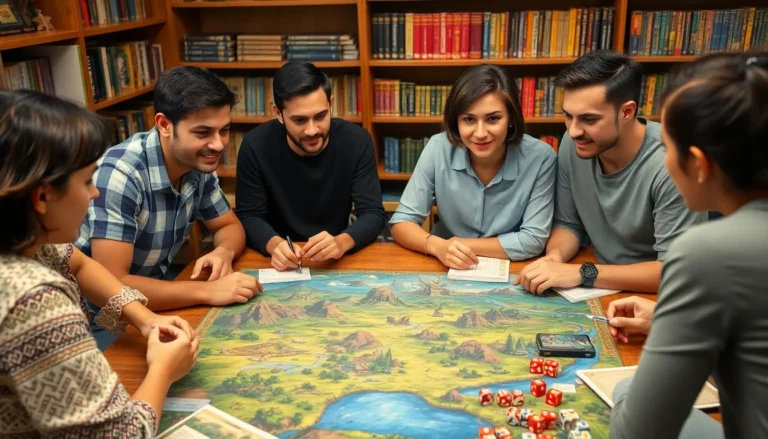Table of Contents
ToggleIn the ever-evolving world of tabletop gaming, ghost RPGs have carved out a unique niche that captivates players with their blend of storytelling and supernatural elements. These games invite participants to step into the shoes of spirits and specters, navigating haunted landscapes and unraveling mysteries that blur the lines between life and death.
As players immerse themselves in these eerie adventures, they encounter a rich tapestry of lore and character development, making each session a thrilling experience. With a focus on atmosphere and narrative depth, ghost RPGs offer an engaging alternative for those seeking a fresh twist on traditional role-playing games. Whether it’s exploring abandoned mansions or solving age-old riddles, the allure of the unknown keeps players coming back for more.
Overview of Ghost RPG
Ghost RPGs combine storytelling with supernatural themes, immersing players in rich narratives. Players often take on roles of spirits, navigating haunted environments that challenge perceptions of reality. The gameplay typically revolves around unraveling mysteries, facing moral dilemmas, and solving ancient puzzles.
In these games, character development plays a crucial role. Players build unique backstories that explain their spectral existence, influencing their decisions and interactions. This depth enhances overall engagement and investment in the narrative.
Eerie locations serve as backdrops for adventures in ghost RPGs. Environments range from abandoned mansions to cursed forests, each filled with hidden secrets. Players explore these settings, where each discovery adds layers to the plot.
Ghost RPGs also leverage folklore and myth, incorporating cultural elements that enrich the experience. These influences create diverse worlds, offering players a glimpse into different beliefs surrounding the supernatural.
The engagement factor remains high due to the blend of challenges and storytelling. Players re-evaluate their strategies as they confront both the physical and metaphysical aspects of their adventures, ensuring that every session offers new surprises.
Gameplay Mechanics

Ghost RPGs feature immersive gameplay mechanics that enhance storytelling and player engagement. Key components include character creation, game world exploration, and conflict resolution, which together create a dynamic gaming experience.
Character Creation
Character creation in ghost RPGs significantly influences gameplay. Players develop unique characters, complete with distinct backstories, traits, and motivations. This process encourages creativity and personal investment in the narrative. Character attributes often determine how players interact with the supernatural, influencing capabilities such as ghost abilities, intuition, and empathy. Each character’s choices impact the game’s direction and outcomes, fostering deeper connections to the unfolding story.
Game World Exploration
Game world exploration emphasizes atmospheric environments and narrative immersion. Players navigate eerie settings, such as abandoned mansions and haunted forests, using detailed maps and sensory descriptions. Exploration often reveals hidden clues, lore, and interactive elements that drive the story forward. Players encounter challenges such as traps and adversarial entities that test their characters’ skills and decision-making. This exploration fosters collaboration, as players must communicate and strategize to unearth secrets and survive encounters, enriching the overall gameplay experience.
Unique Features of Ghost RPG
Ghost RPGs offer distinctive elements that enhance storytelling and player engagement through immersive gameplay mechanics.
Spirit Interaction
Spirit interaction serves as a core mechanic in ghost RPGs. Players embody spirits, allowing them to communicate with otherworldly entities, including wraiths, poltergeists, and friendly apparitions. This interaction often involves negotiating, solving their unresolved issues, or gathering valuable insights into the narrative. Successful engagement can unlock special abilities or reveal critical plot points. The dynamics of these relationships deepen the player’s emotional connection to the game world, offering unique perspectives on morality and consequence.
Quest System
The quest system in ghost RPGs stands out through its emphasis on narrative-driven objectives. Quests range from solving ancient mysteries to aiding spirits in their unfinished business. Each quest intertwines with character backstories and the game’s overarching plot, ensuring players remain invested in the outcome. Additionally, quests often incorporate multiple paths and outcomes, allowing player choices to shape the narrative. This flexibility fosters replayability, encouraging exploration of different character decisions and their impacts on the game world.
These unique features of ghost RPGs not only enrich gameplay but also create a captivating experience that resonates with players long after the session ends.
Graphics and Sound Design
Graphics and sound design play crucial roles in enhancing the immersive experience of ghost RPGs. Visually, developers often use stylized art and haunting color palettes to create an eerie atmosphere that reflects the supernatural themes. High-quality illustrations and character designs depict spirits, environments, and artifacts, serving to draw players deeper into the narrative. Unique design choices, such as shadowy figures or flickering lights, evoke feelings of suspense and intrigue, enriching gameplay.
Sound design complements the visuals by establishing an audio landscape that reinforces the ghostly atmosphere. Ambient sounds, such as whispers, creaking floors, and distant thunder, contribute to an unsettling environment that keeps players alert. Dynamic soundscapes adapt to gameplay scenarios, transitioning from eerie silence to sudden bursts of noise during critical moments. Voice acting enhances character interactions, adding emotional weight and authenticity to dialogues.
Together, graphics and sound design elevate the storytelling aspect of ghost RPGs. They work in tandem to create an engaging experience that allows players to feel as though they’ve stepped into a haunted world, enhancing interactions with characters and settings. This combination of visual and auditory elements ensures a captivating atmosphere that immerses players in the haunting narratives they explore.
Community and Player Feedback
Community engagement plays a significant role in the evolution of ghost RPGs. Players actively share their experiences, strategies, and character creations on various platforms such as forums and social media. This shared dialogue fosters a vibrant ecosystem where ideas flourish and inspire new gameplay elements.
Feedback from the player base signifies what aspects resonate most strongly. Many players express a deep appreciation for the intricate narratives and character development. Enthusiasts often highlight the moral dilemmas faced in the game, finding value in how these choices impact character growth and story outcomes. Additionally, suggestions for enhancing gameplay mechanics or introducing new spirit interactions often arise from community discussions.
Surveys and player polls provide developers with insights into preferences and potential improvements. The community’s input has led to regular updates, addressing gameplay balance, narrative depth, and user experience. Collaborative playtesting sessions allow dedicated fans to partake in the development process, influencing the direction of future expansions.
Online platforms often serve as a hub for sharing custom scenarios and homebrew content. Players showcase their creativity by crafting unique adventures, complete with tailored rules and story arcs, which further enriches the ghost RPG landscape. This creativity not only deepens the investment among players but also promotes a sense of belonging within the community.
The diverse feedback and collaborative mindset within the ghost RPG community drive innovation and ensure that games remain engaging and reflective of their players’ experiences. The synergy between developers and players promotes a thriving environment that continually rejuvenates the genre.
Ghost RPGs offer a captivating blend of storytelling and supernatural elements that resonate deeply with players. Their immersive gameplay mechanics and rich narratives create unforgettable experiences that challenge players’ creativity and decision-making skills. As the community continues to engage and share, these games evolve, ensuring fresh content and innovative ideas that keep the spirit of adventure alive.
With their unique settings and moral dilemmas, ghost RPGs not only entertain but also provoke thought and reflection. This genre’s ability to intertwine folklore and personal narratives enhances its appeal, drawing in both seasoned gamers and newcomers alike. As they explore haunted worlds, players find themselves not just participating in a game but becoming part of a hauntingly beautiful story that lingers long after the session ends.






